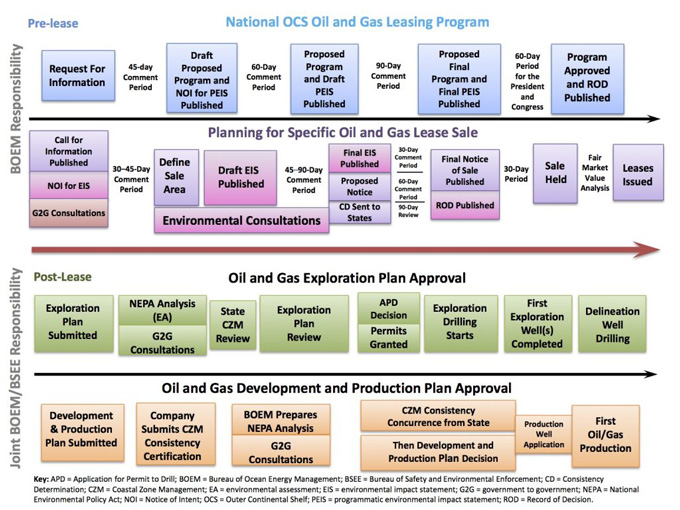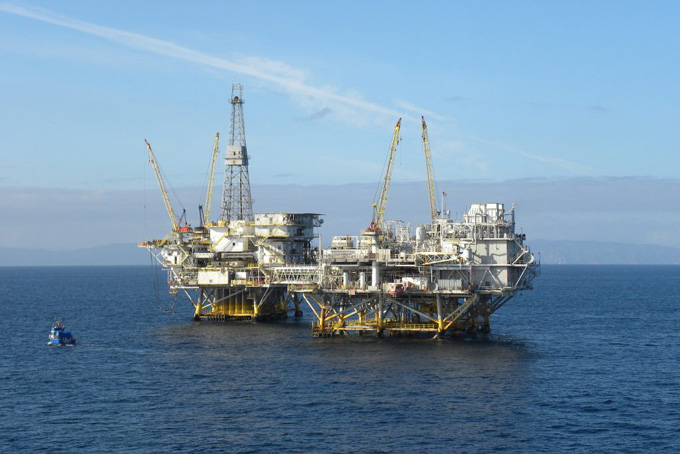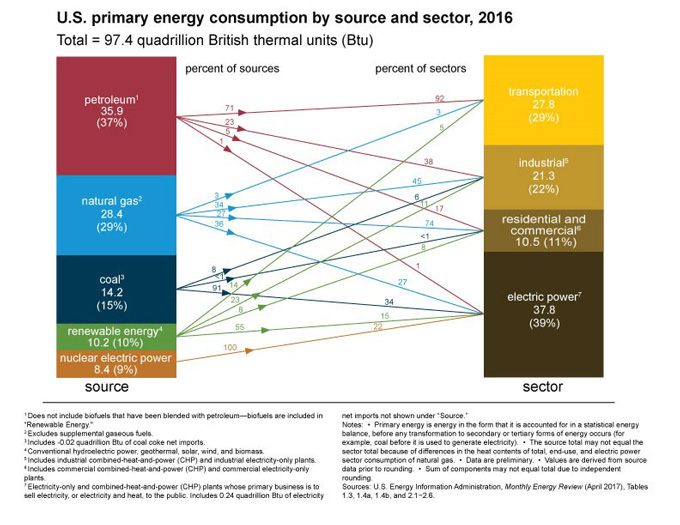Unit 8 – U.S. Management of Offshore Energy
U.S. Management of Offshore Energy
Contents
Introduction
The Submerged Lands Act
The Outer Continental Shelf Lands Act
Offshore Renewable Energy: Wave, Wind, Current, Tidal Energies
Introduction
While most marine management professionals may never encounter energy leasing in their careers, understanding how US ocean energy leasing works is important for several reasons. Leasing, exploration, and extraction can be planned to avoid space conflicts with other ocean uses, these activities potentially impact our ocean ecosystems and resources, and we are consumers of minerals and energy whether it is oil, gas, or electricity potentially powered by wind, waves, tides, or currents.
The provisions of the Endangered Species Act (Unit 2) in Sections 7 and 9 apply to activities related to energy; offshore activities such as oil exploration and the construction of wind turbines require permits (from the Federal Energy Regulatory Commission (FERC) or the Bureau of Ocean Energy Management at the leasing phase (BOEM)) for incidental take, and such activities may not cause a threatened or endangered species to be jeopardized. Leasing within specific regions including portions of Artic seas may be covered by programmatic biological opinions.
This unit will briefly look at how the US manages the exploration and leasing of offshore energy resources (minerals, oil, gas, and alternatives such as wind, wave, tidal and current energy).
The Submerged Lands Act
In order to establish certainty following years of lawsuits between coastal states and the federal government about jurisdiction, in 1953 Congress passed the Submerged Lands Act (SLA, 43 USC §1301 et seq.) to simultaneously quitclaim most federal rights, and establish state rights, in the navigable waters and adjacent seabed within nearshore waters to the coastal states. The SLA applies to waters and submerged areas within three miles (except for the Gulf Coasts of Texas and Florida which extend to three marine leagues or 12 miles due to historic claims). The Act confers jurisdiction, management and stewardship responsibilities to the coastal states, with exceptions. The federal government reserves traditional authorities under with regard to “the use, development, improvement, or control by or under the Constitutional authority of Congress to regulate or improve navigation, or to provide for flood control, or the production of power…” (43 USC § 1311 (d)).
Undersea cable is an example of a seabed use requiring leases and permits. Applications include undersea communications cable, and electric cable used to connect offshore energy installations such as wind energy facilities to the mainland. During the project application and planning phase, companies must be authorized through seabed leases in order to install cable necessary to the project. Both examples (communication, energy) would require both federal (Bureau of Ocean Energy Management, within the US Department of the Interior) and state leases and permits since the cable covers the span of both seabeds.

In state waters, one or more agencies in each coastal state will be involved in reviewing lease applications of the state’s seabed area. The financial proceeds from leases generate revenue for the state, although the fees are often modest. Proposed projects and activities requiring federal permits and licenses within state waters must be consistent with the state’s coastal zone management plan under the US Coastal Zone Management Act of 1972 (CZMA 16 USC Ch. 33 §1451 et seq.).
In Oregon, seabed regulation is divided between two agencies. The Oregon Division of State Lands (DSL) authorizes, permits, and oversees activities involving the seabed and Oregon Department of State Land Conservation and Development (DLCD) handles Coastal Zone Management Act (CZMA) Section 7 federal-state consistency review. The CZMA is covered in Unit 9 on US Coastal Management.
The Outer Continental Shelf Lands Act
Five-year leases for the exploration, development and production of minerals, oil and gas within three to 200 miles offshore are governed by Section 18 of the Outer Continental Shelf Lands Act of 1953 (OCSLA, 43 USC §§1331-1356). OCSLA Section (B) includes the recognition that offshore resource development can have adverse impacts on coastal states, and provides that a portion of the lease receipts from the OCS is available for coastal states and localities to use for mitigation of “adverse economic and environmental effects related to the development of such resources.” Section C provides that coastal states and local governments “are entitled to an opportunity to participate, to the extent consistent with the national interest, in the policy and planning decisions made by the Federal Government relating to exploration for, and development and production of, minerals of the Outer Continental Shelf.”
The term Outer Continental Shelf (OCS) pertains to all submerged lands seaward and outside of the area beneath navigable waters subject to US jurisdiction and control, a definition that adheres to the Law of the Sea (UNCLOS). The US State Department defines the extended shelf (or the ECS, beyond 200 miles from shore) as that part of the shelf beyond our EEZ, currently being studied and mapped by their project. A BOEM presentation features a useful flowchart (below) of steps in the pre-lease and post-lease phases of oil and gas exploration and development.
In 2016, the US generated around 91% of the energy consumed, with the remainder accounted for by net petroleum imports which have been decreasing for several years, a reduction that also implies fewer oil tankers importing foreign oil to US ports. Fossil fuels (natural gas, petroleum, and coal) still comprise most US energy production (US Energy Information Administration).

The national leasing program undergoes periodic changes due to the priorities of Congress and whatever political administration is in power. For example, in April 2017, Executive Order (13795) announced an expansion of offshore leasing to access increased domestic oil and gas supplies. The new leasing program will affect 2019-2024 and will replace all or part of the approved, previous 2017-2022 program. A one-page history of oil drilling (by the US Marine Mammal Commission) is available access it here. In contrast to recent calls for a massive expansion of US offshore areas to oil and gas drilling, in economic reality the chance of ever exploiting those areas may be small. A recent report summarized it this way. “Almost two-thirds of the nation’s oil reserves that companies can hope to drill for while still turning a profit lie in seas already open to drilling…The abundance of cheap oil and gas from onshore fracking in the United States has already diminished the incentive for companies to go drill in new offshore zones.” The article also notes the enormous risks and costs involved in investing in new offshore wells. (New York Times, 2018). For information on the longstanding moratorium on US West Coast (CA, OR, and WA) offshore drilling and former President Obama’s action to extend the West Coast moratoria, see here.
The final Programmatic Environmental Impact Statements (PEIS) for the original 2017-2022 oil and gas program, and the final Record of Decision (ROD) for the original plan, are available here. Any time a federal action (including granting permits or leases) poses any impacts that are economic, social, or environmental, the lead agency must prepare a mandatory Environmental Impact Statement (EIS), under the National Environmental Policy Act of 1969 (NEPA 42 USC §§4321 et seq.).

Recall that all revenue-producing activities within coastal waters and the United States EEZ must, by law, conserve and protect ecosystems and natural resources as well as provide a fair market return to coastal states and the nation, since the oceans are common property and the state and federal government have a mandatory stewardship responsibility as the Trustee. This responsibility is embedded in the language of SLA and the OCSLA, and is the reason for detailed environmental review documentation.
Offshore Renewable Energy: Wave, Wind, Current, Tidal Energies
The SLA and OCSLA also pertain to offshore renewable energy, which consists of energy derived from wind, waves, tides, or currents. These renewables have varying pros and cons, cost per kW hour and other economic considerations, and empirical environmental data depending on location. However, over time the cost of many offshore renewables is decreasing as the designs become more efficient.
The Bureau of Ocean Energy Management oversees leasing and permits connected to wind power. This jurisdiction was granted in the Energy Act of 2006.
Wind energy is the most advanced and established so far, and the United States first offshore wind project came online through the Block Island Wind Farm in December 2016. As indicated in Unit 3 (Managing Through Specially Designated Areas) offshore energy siting is planned far in advance, after years of collecting scientific data on suitability or sensitivity of offshore ecosystems and input from stakeholders including fishermen and recreationalists, mapping and zoning of the substrate and overlying waters.
The facilities can serve as data collection sites on wildlife. Wind energy installations on land or at sea have potential impacts to wildlife. As of September 2017 the facility at Block Island (off Rhode Island) became one of 40 tracking stations on the East Coast for collecting data on migrating seabirds and bats using VHF technology in conjunction with US Fish and Wildlife Service.

While each individual project site will have its own EIS under NEPA, BOEM developed a programmatic EIS for the whole US offshore wind program in 2007. This PEIS is available at: boem.gov/Guide-To-EIS/.

The regulations pertinent to leases for OCS renewables are located in 30 CFR Ch. V Subpart B, 500.200-585.437 (inactive link as of 05/19/2021). BOEM also provides information on the regulatory framework for offshore wind, and links to learn more about offshore wind, wave, current and even solar energy: boem.gov/Offshore-Wind-Energy/ (inactive link as of 05/19/2021).
At least fifteen coastal states (California, Delaware, Florida, Georgia, Hawaii, Maine, Maryland, Massachusetts, New Jersey, New York, North Carolina, Oregon, Rhode Island, South Carolina, and Virginia, in addition to regional proposals) had some offshore renewable energy projects under development at the end of 2017. A map and a list linked to specific information by state is available at: boem.gov/Renewable-Energy-State-Activities/. Offshore renewables are only one part of states’ renewable energy portfolio standards (REPS) that include other sources such as solar.
California, as a geographically large and populous (39.5 million) state, makes a useful illustration. The state has a 50% renewable energy goal by 2030. The website of the California Offshore Wind Energy Gateway features news, maps, and information about the state’s progress. California’s offshore wind resources are estimated to offer more than 158,000 Gigawatts (GW) of electricity (a single GW can power up to 350,000 homes). At this scale, clean power offers enormous implications for reducing carbon emissions and their impacts on marine and coastal ecosystems (including the potential for reducing ocean acidification) thus also holding promise for protecting coastal economies such as fisheries.

Energy generated by water (hydrokinetic) includes electricity from waves, tides, or currents. BOEM (and any coastal states involved) reviews seafloor lease applications for hydrokinetics. The Federal Energy Regulatory Commission (FERC) governs hydrokinetic energy installations under the Federal Power Act (FPA) of 1935 (16 USC Ch. 12). FERC reviews applications, siting and environmental documents for hydrokinetic pilot projects (three-year permits for trials) and 30-50 year licenses for proven technologies in accordance with state comprehensive plans as dictated by the FPA. To date, very few hydrokinetic projects have been licensed (see FERC Hydrokinetics site).
Unit 9 will present the framework for management of the framework and partnership between the federal government (through NOAA) and the 35 coastal states, which include the Great Lakes, for managing shorelines and resources in coastal waters.
Notes
Tabuchi H, Wallace T (2018) Trump Would Open Nearly All US Waters to Drilling. But Will They Drill? The New York Times, January 23, 2018. Comparing the oil exploration of three presidents, with maps: nytimes.com/interactive/2018/01/23/climate/trump-offshore-oil-drilling.html
Unit 8 Study Questions
- If the OCSLA anticipates participation of coastal states and localities in decision-making, what does this imply about levels of scrutiny for environmental review? What are some of the stakes for coastal states with proposed leasing in or adjacent to their waters? Why did Congress include these provisions in the statute?

